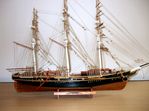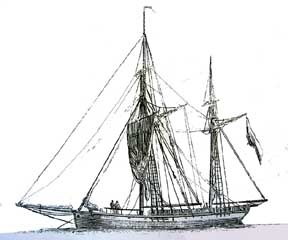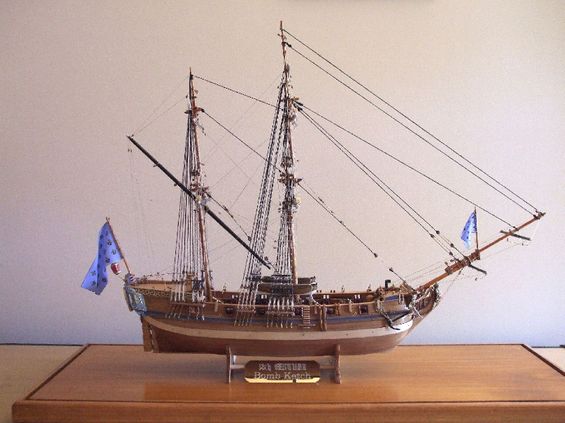Classic Ship Models 5
A PROFILE
Galiot - a French Bomb Ketch (Per courtesy Dictionnaire de la Marine)
A PROFILE OF BOMB KETCHES
The concept of the Bomb Ketch originated with the French Navy. The first vessel of its kind, the "Bombarde" was built in Dunkirk in 1681. The early French vessels had two forward pointing mortars fixed side by side on the foredeck. To aim these weapons, the entire ship was rotated by paying out or hauling in the spring anchor.
The French design was copied by the Royal Navy which modified the class over the years. The forward facing mortars were replaced with mortars mounted on rotating platforms on the centreline. These, in turn, were supported by strong internal structures to transmit the firing forces to the hull.
Early bomb vessels were rigged as ketches with two masts, the foremast being deleted. They were awkward to sail and manouevre partially because the masts were stepped further aft than normal in order to accommodate the mortars. As a result, by the 1770's, British vessels of this type were designed as fully rigged ships with three masts. It was typical to have the forward rigging made of chain to protect against the muzzle blasts.
Mortars were the only kind of naval armament to fire explosive shells rather than solid shot. Since it was considered dangerous to have large stocks of ammunition on board and because the reinforced mortar platforms below deck occupied so much space, bomb vessels were often accompanied by a tender which carried ammunition as well as the ordnance officers who were in charge of firing the mortars.
THE MODEL
A FRENCH DESIGNED TYPICAL BOMB KETCH 18TH CENTURY
This particular model depicts the original French design with two masts and the two mortars positioned on the foredeck. The French 'Fleur de Lys' ensign flies from the poop deck and on the bowsprit. The model was built from a kit designed by Amati of Italy who produce many fine models of 'different' type ships, with excellent material. This one has a scale of 1:80 and, being quite a small scale, has a length of just 600 mms overall, and is 440 mms from keel to topmast.
The profile describes the design and modifications made by the British but not the purpose they generally fulfilled. They were primarily
designed for bombarding shore establishments. During the 17th, 18th and 19th centuries, the navies of Britain, France and Spain used these vessels for the initial destruction of shore fortifications when they were attacking enemy ports. The mortars were capable
of firing their shells in a parabolic curve with greater range than the more heavily armed fighting ships of their day.
Being smaller than the other vessels in the fleet and having a shallower draft, it enabled them to approach closer and effectively clear the way for the fleet to attack with less impediment.The model itself is one of the neatest and detailed of its kind and is quite challenging. It took about 5 months of leisure time to complete.


